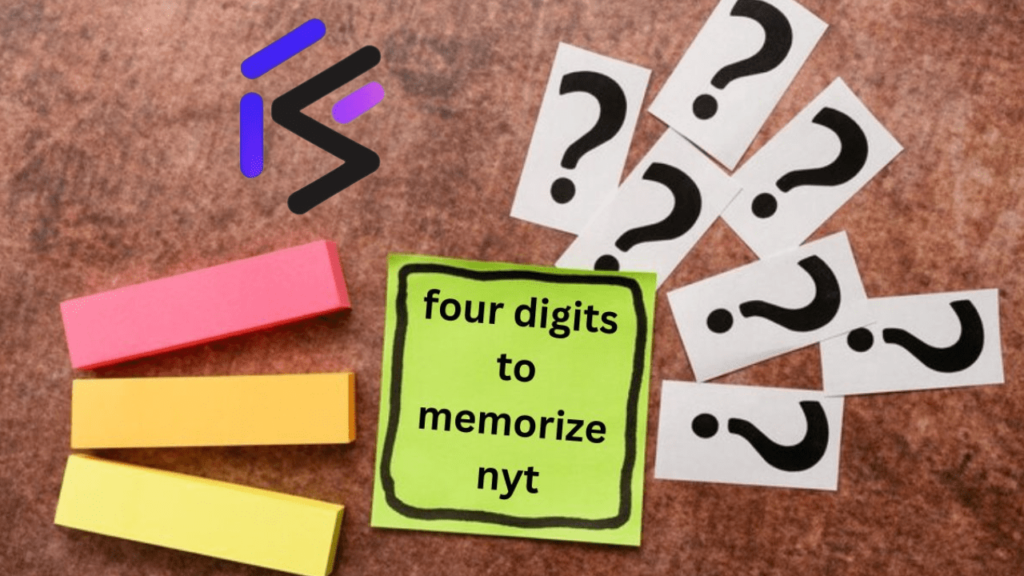Introduction of Four Digits to Memorize NYT
In the fast-paced and busy world that we live in today, a good memory plays an Vital and critical role every day. Memory dates that matter, phone numbers, or even just a Basic grocery list can truly make a significant impact and difference. One interesting and captivating area to enhance memory skills is by mastering the art of memorizing random sequences of digits. In this insightful and enlightening article, we will dive deep into various memory techniques and discover effective ways to memorize four digits from The New York Times (NYT) accurately and efficiently!
Remember dear readers, that enhancing your memory abilities can open doors to limitless opportunities and improve your daily life significantly. So let’s begin this exciting journey to sharpen our memory skills together!
Key Steps to Memorizing Four Digits from NYT
- Selection of Digits: Begin by carefully selecting the four digits from The New York Times that you wish to memorize. Choose wisely and focus on numbers that resonate with you personally.
- Visual Representation: Create vivid and imaginative visualizations of the digits in your mind. Picture them as colorful and vibrant images to aid in retention.
- Association Technique: Link each digit with a meaningful word or phrase that will help you remember them in the correct order. Connect the digits in a way that forms a cohesive story in your memory.
- Repetition Practice: Practice recalling the four digits regularly throughout your daily routine. Repetition is key to solidifying your memory and ensuring long-term retention.
- Review and Test: Periodically review and test yourself on the four digits you have memorized. Challenge yourself with different sequences to keep your memory sharp and agile.
Also Read: A Complete Guide Jaart011 Benefits, Future and Significance
Overview of the Four Digits for NYT Memorization
The four digits to memorize nyt from The New York Times can represent various dates, quantities, or other numerical values. They may appear in articles, headlines, or other nyt contnent published by the NYT, and individuals may choose to memorize them for personal reasons or as part of memory enhancement exercises.
The memorization of these specific numbers or sequences is a perculiar task that some readers find of great interest. The reasons for memorizing these numbers might differ greatly, but the challenge of storing them in your brain can be quite perplexing!
To memorize certain digits from NYT, you need to understand the numerical values they hold in relation to the articles’ themes or events. The task might seem daunting initially, but with practice and determination, it can be a rewarding mental exercise too much improve your memory skills and cognitive functions. So next time you come across a set of numbers in the NYT, consider giving your memory a little workout by trying to memorize them!
Why Memorizing These Digits Is Important
Memorizing these digits can serve as a mental exercise to improve memory retention and recall. It can also be a fun way to challenge oneself and Progress new mnemonic techniques. Additionally, some people may find personal significance in specific numbers and choose to memorize them as a form of personal enrichment.
2,021
This number represents the current year and may be significant for individuals looking to commemorate the year or track events related to it.
7
The number seven holds various cultural and symbolic meanings across different contexts, making it a number of interest for many people.
1,260
This number could represent a historical date, a quantity, or another significant value relevant to a specific context within The New York Times.
3
The number three is a fundamental digit with diverse symbolic and cultural significance, making it a popular choice for memorization exercises.
Tips and Strategies to Easily Memorize the Four Digits
- Chunking: Break the digits into smaller groups or chunks to make them easily to remember. For example, you could break 2,021 into 20, and 21 and 15.
- Visualize: Create mental images or stories that connect the digits in a memorable way. For instance, you could imagine the digits forming a shape or interacting with each other in a meaningful scene and remember it with clarity.
- Association: Associate each digit with something familiar to you or with objects surrounding you. For example, you could associate 7 with the number of days in a week and apples from the tree.
- Repetition: Practice recalling the digits regularly to reinforce your memory. Redundancy is critical to hardening your memory and guaranteeing long haul maintenance.
- Use Memory Techniques: Explore mnemonic devices such as the Method of Loci or the Peg System to enhance your memorization abilities and improve fast recollection.
Common Mistakes to Avoid When Memorizing the Digits
- Overcomplicating: Avoiding overcomplicating the memorization process. Keep your strategies simple and easy to recall with skills.
- Lack of Focus: Ensure you are fully focus when practicing memorization. Distractions can hinder your progress, and confuse your mind.
- Skipping Practice: Consistent practice is essential for memorization. Skipping practice sessions can slow down your progress, causing confusion in your learning journey.
How Can I Best Memorize the Four Digits?
The best approach to memorizing the four digits is to Discover a method that works best for you. Experiment with different strategies and techniques until you find one that feels natural and effective. Retain that everyone’s memory works Contrarily, so what works for one person may not work for another.
Comprehending the Four-Digit Memorization Method for NYT
The four-digit memorization method for The New York Times involves using memory techniques to encode and store the digits in your memory. This method taps into the brain’s ability to create associations and patterns, making it easier to recall the digits when needed and go along with your reading.
Conclusion
Memorizing four digits from The New York Times can be Also a challenging mental exercise and a fun way to Interact with your memory. By using effective memorization techniques such as chunking, visualization, and association, you can Better your memory skills and impress your friends with your newfound ability to recall specific digits at will. Great work, you can do it as long as you believe!
And so, Recall when you read those numbers 3, 4, 5, and 6, do not forget to See at them with your eyes wide open so that they Remain in your mind forever. Yes, forever! Regular if you feel like giving up, just keep going and do not give in to the temptation to stop. Practice, practice, practice! You’ll get there eventually, guaranteed. So why not give it a try? Learn the four digits today and be amazed by your memory improvement tomorrow!
Faqs About Four Digits to Memorize nyt
Why should I memorize four digits from The New York Times?
Memorizing digits can serve as a mental exercise to improve memory retention and recall. It can also be a fun way to challenge yourself and Grow new Association techniques. Additionally, some people may find personal significance in specific numbers and choose to memorize them as a form of personal enrichment.
How can I best memorize the four digits?
The best approach is to Discover a method that works best for you. Experiment with different strategies and techniques until you find one that feels natural and effective. Retain that everyone’s memory works Contrarily, so what works for one person may not work for another.
Are there any common mistakes to avoid when memorizing the digits?
Yes, some common mistakes include overcomplicating the memorization process, lacking focus during practice, and skipping practice sessions. It’s Crucial to keep your strategies simple, stay focused, and practice regularly to Better your memorization skills.


